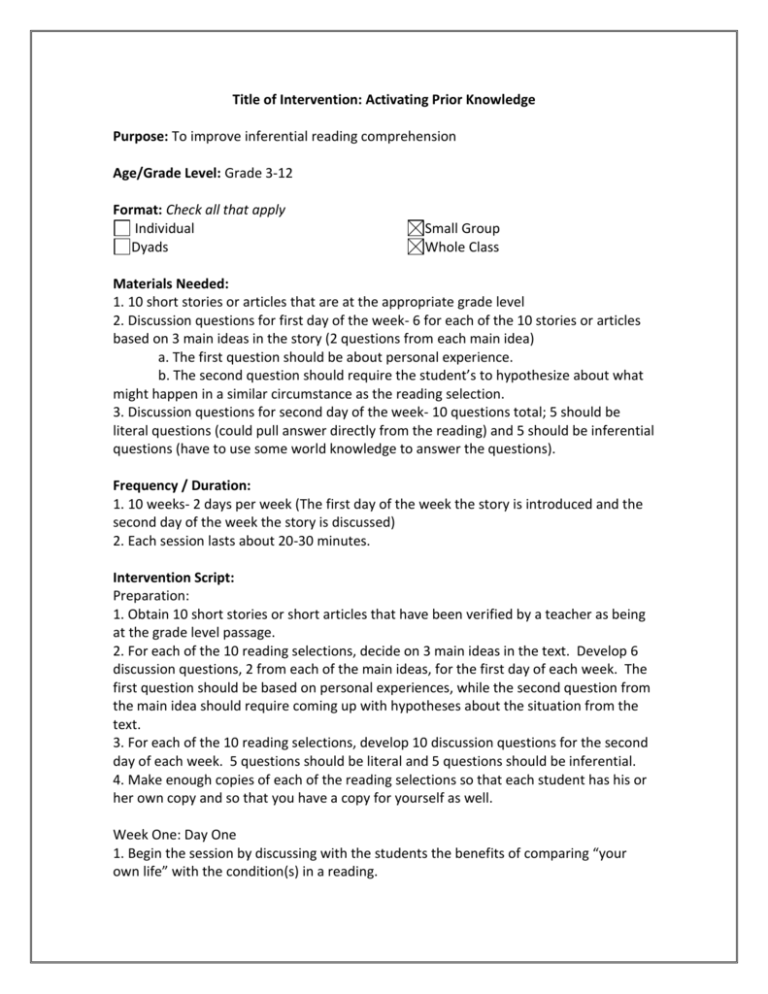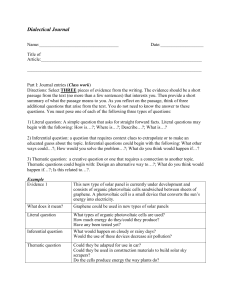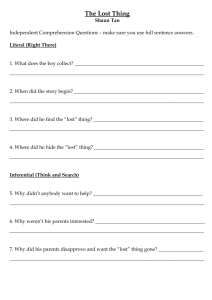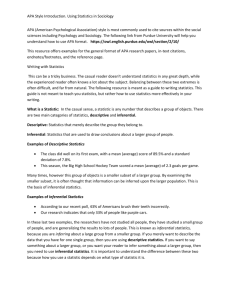Activating Prior Knowledge
advertisement

Title of Intervention: Activating Prior Knowledge Purpose: To improve inferential reading comprehension Age/Grade Level: Grade 3-12 Format: Check all that apply Individual Dyads Small Group Whole Class Materials Needed: 1. 10 short stories or articles that are at the appropriate grade level 2. Discussion questions for first day of the week- 6 for each of the 10 stories or articles based on 3 main ideas in the story (2 questions from each main idea) a. The first question should be about personal experience. b. The second question should require the student’s to hypothesize about what might happen in a similar circumstance as the reading selection. 3. Discussion questions for second day of the week- 10 questions total; 5 should be literal questions (could pull answer directly from the reading) and 5 should be inferential questions (have to use some world knowledge to answer the questions). Frequency / Duration: 1. 10 weeks- 2 days per week (The first day of the week the story is introduced and the second day of the week the story is discussed) 2. Each session lasts about 20-30 minutes. Intervention Script: Preparation: 1. Obtain 10 short stories or short articles that have been verified by a teacher as being at the grade level passage. 2. For each of the 10 reading selections, decide on 3 main ideas in the text. Develop 6 discussion questions, 2 from each of the main ideas, for the first day of each week. The first question should be based on personal experiences, while the second question from the main idea should require coming up with hypotheses about the situation from the text. 3. For each of the 10 reading selections, develop 10 discussion questions for the second day of each week. 5 questions should be literal and 5 questions should be inferential. 4. Make enough copies of each of the reading selections so that each student has his or her own copy and so that you have a copy for yourself as well. Week One: Day One 1. Begin the session by discussing with the students the benefits of comparing “your own life” with the condition(s) in a reading. 2. Say, “Before we begin discussing a story, the first thing we do is think and talk about our lives and how they compare to the story. The reason we make these comparisons is because it helps us to better understand the story or reading.” 3. After this discussion, briefly introduce the topic of the week’s reading. For example, if the story was about famous explorers, your might say, “Pretend you are reading a story or article about famous explorers in history. While reading it, what might you think about? Make sure to try to relate it to your everyday life.” 4. Call on the students one-by-one as they raise their hands to give ideas about what they would think about. As the students give ideas and predictions, do no indicate whether they are correct or incorrect. Be sure to give positive feedback to each student that gives a suggestion. The idea behind this is for the students to make connections between themselves and the text prior to reading in order to enhance their interaction with the story or article while reading. 5. Introduce the first Main Idea from the reading selection for this week. For example, if the story about the famous explorers had them get lost you might say, “Sometimes if people have not been to a place before and do not know exactly where they are going, they might get lost.” 6. Then ask the first discussion question about the Main Idea related to personal experience. For example, you might say, “Tell me about a time when you got lost or did not know where you were going.” One-by-one, as the students raise their hands to answer, call on them to give examples about this. 7. Next, ask the second discussion question about the Main Idea related to hypothesizing about the situation. For example, you might say, “In today’s reading selection, the explorers get lost. Where do you think they were going, and why do you think they got lost?” One-by-one, as the students raise their hands to answer, call on them to give examples about this. 8. After all discussion of the 3 Main ideas is complete; hand out this week’s reading selection. Tell the students to read the story independently and silently. Once they are finished, collect the readings. Week One: Day Two 1. Begin today’s session by handing out the reading selection from this week. Tell the students again to read the story independently and silently. This time let them keep the reading with them at their desk. 2. Once all the students have re-read the selection, tell them that now you are going to ask a few questions about what they just read. 3. For literal questions: An example of a literal question might be, “Where were the explorers going when they got lost?” To answer this question, students would have to look at the reading because the story says were the explorers were going. Call on a student to answer the question and have them show you where they found the answer in the reading. 4. For inferential questions: An example of an inferential question might be, “Why were the explorers scared and worried?” The reading selection may only have said that they were scared and worried, but did not explicitly state why. For these questions, the students need to infer the answer by using their outside knowledge to make an interpretation. This time, call on students one-by-one to answer the questions with what they think the answer might be. 5. Go through the 10 Discussion questions for this week’s reading selection. After you’ve gone through all the questions, ask the students if they have any questions about the story or the discussion. 6. Remind the students that some questions about readings can be answered just by looking through the reading, while other questions about readings can only be answered by making interpretations through drawing from outside knowledge. Week Two: Day One 1. Begin this session by reminding the students of the benefit of comparing “your own life” with the situation(s) in the reading. 2. Ask the students, “What is the first thing we do before discussion or thinking about a story?” The student’s answers should be along the lines of: “The first thing we do is think and talk about our lives and how our lives compare to the situation in the story.” If students do not know the answer or do not answer correctly, remind them of the answer. 3. Ask the student, “Why do we make these comparisons?” The student’s answers should be along the line of: “We make these comparisons because they help us to better understand the story or reading selection.” If students do not know the answer or do not answer correctly, remind them of the answer. 4. Just like in Step 3 of “Week One: Day One”, briefly introduce the topic of the week’s reading. Ask students to relate their everyday lives to the topic of the week’s reading. 5. As the student’s raise their hands to answer or give ideas about what they might think about, call on them one-by-one. Do not indicate whether they are correct or incorrect, but be sure to give all students positive feedback for their suggestion. 6. Just like in Step 5 of “Week One: Day One”, introduce the first discussion question Main Idea from the reading selection for this week. 7. Go through each of the 6 questions based off of the 3 Main ideas from the reading selection to generate discussion. 8. After discussion is complete, hand out this week’s reading selection. Tell the students to read the story independently and silently. Once they are finished, collect the readings. Week Two: Day Two 1. Begin the session by handling out this week’s reading selection. Have the students reread the story, this time letting them keep the text at their desk once they have finished reading. 2. Once all the students have re-read the selection, tell them that now you are going to ask a few questions about what they have just read. 3. For the 5 literal questions: Answering these questions correctly require the students to find the exact answer in the text. For each question, call on a student to answer the question and have them show you where they found the answer in the reading. Make sure no other students have questions about how to answer the question. 4. For the 5 inferential questions: Answering these questions requires students to use outside knowledge to make an interpretation about the reading. For each question, call on students one-by-one to give a suggestion for the answer and a reason for why they believe that is the answer and or how they came to that conclusion. 5. Go through all of the 10 discussion questions, mixing up the order of the literal and inferential questions. 6. After you are finished, make sure the student’s do not have any questions about either the reading selection or the discussion. 7. Remind the students that some questions about readings can be answered just by looking through the reading, while other questions about readings can only be answered by making interpretations. Week Three-Ten: Day One 1. For the next 8 weeks, follow the same steps from “Week Two: Day One” Week Three-Ten: Day Two 1. For the next 8 weeks, follow the same steps from “Week Two: Day Two” Data Collection: 1. Prior to beginning the intervention, have all students read 2 selections from a grade level passage. 2. Then have each student answer 6 questions about each of the readings: 3 literal and 3 inferential. 3. The literal questions can be scored according to if they are correct or incorrect. 4. The inferential questions can be scored on a 5-point scale: 5 points: A correct answer that reflects drawing an inference between the text and prior knowledge. 4 points: A correct answer that is based on an inference, but draws too much from the text or too much from prior knowledge 3 points: An incorrect answer that related to an inference, but gives no reference to the text or prior knowledge 2 points: An incorrect answer that is copied from the text 1 point: No response given 5. Graph the results of the two reading on the baseline (“A”) section of an A-B graph for each student. 6. Halfway through the intervention, after 5 weeks, and at the end of the intervention, after 10 weeks, have all student read a grade appropriate reading selection and answer 3 literal and 3 inferential questions about the text. Score the 6 questions the same way. Graph the results of these reading in the “B” section of the A-B graph for each student. 7. To measure maintenance: At 3 and 6 weeks after the completion of the intervention, have all students read a grade level passage and answer 3 literal and 3 inferential questions about the text. Score the 6 questions the same way as above. Graph the results of these reading selection results to the right of the “B” section of the A-B graph. References: Hansen, J. & Pearson, P.D. (1983). An Instructional Study: Improving the Inferential Comprehension of Good and Poor Fourth-Grade Readers. Journal of Educational Psychology, 75, 821-829. Compiled by: Jessica Gibbons








